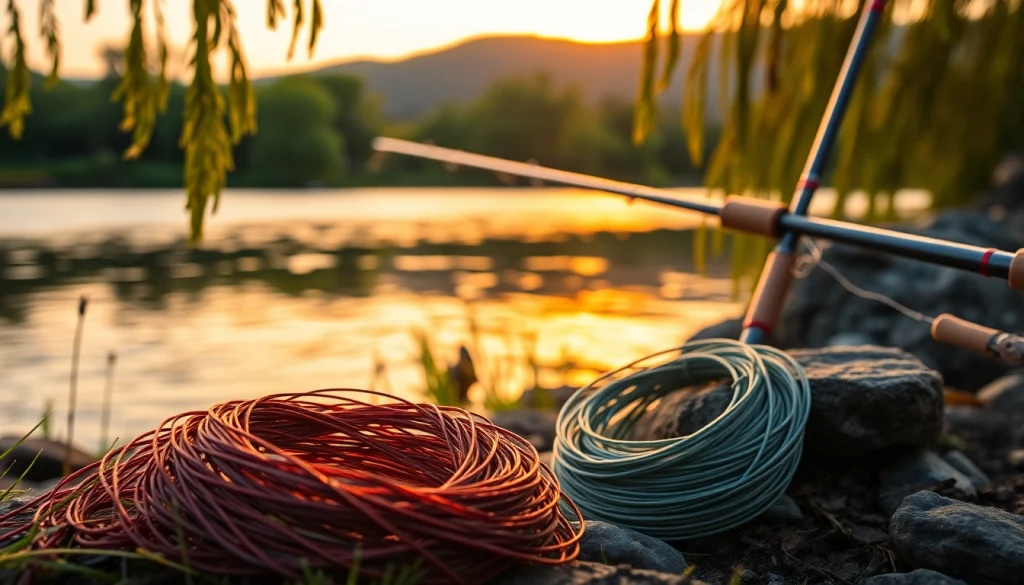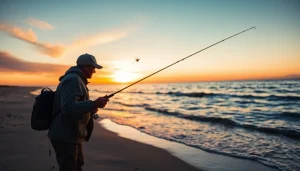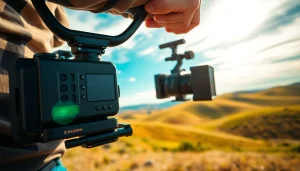Choosing the Perfect Fly Fishing Line for Every Angler

Understanding Fly Fishing Line Types
Choosing the right Fly fishing line is an essential decision for any angler seeking to improve their game. Various types of fly lines exist, each tailored for different fishing techniques, environments, and species. Understanding the nuances of these lines helps in maximizing performance and achieving success on the water. Let’s explore the primary types of fly fishing lines to get you started on the right foot.
Weight Forward Lines Defined
Weight Forward (WF) lines are designed with a heavier front section that allows for easier casting over longer distances. This taper directs the majority of the line’s weight ahead, making it ideal for beginners as well as experienced anglers looking to throw heavier flies or cast into the wind. WF lines typically come in a variety of weights and are suitable for various conditions, including freshwater and saltwater fishing.
Double Taper Lines Explained
Double Taper (DT) lines feature a uniform taper that is thicker in the middle and tapers off at both ends. This design provides versatility, as these lines can be reversed for extended use, effectively doubling their life span. DT lines are particularly effective for delicate presentations, especially when targeting finicky fish in calm waters, making them favored by seasoned fly fishermen.
Sinking and Floating Lines Overview
Sinking and floating lines have distinct purposes in fly fishing. Floating lines are the most commonly used and are excellent for presenting dry flies and nymphs on the water’s surface. Conversely, sinking lines are critical when angling for fish at greater depths or in swift currents. Sinking lines come in various sink rates, allowing anglers to choose how quickly to get their flies into the strike zone. Understanding when to use each type can be the difference between a successful outing and a fruitless one.
Factors to Consider When Selecting Fly Fishing Line
When selecting a fly fishing line, it’s essential to assess several key factors that can affect your overall fishing experience.
Matching Line Weight with Rod Specifications
Every fly rod is rated for a specific line weight, which is crucial for balance and performance. Using a line that matches your rod’s weight specifications enhances casting efficiency and accuracy. It’s advisable to consult your rod’s specifications before purchasing your fly line to ensure compatibility. For instance, pairing a 5-weight rod with a 5-weight line will optimize your casting ability and improve overall control during your fishing experience.
Assessing Fishing Conditions and Environments
Different fishing environments and conditions necessitate varying line characteristics. For instance, fishing on a serene lake may require floating lines for surface presentation, whereas river fishing might call for sinking lines to reach deeper pools. Consider factors such as water depth, current speed, and targeted species when choosing your line. By adapting to environmental conditions, you can increase your chances of success.
Evaluating Line Durability and Performance
The durability of the fly fishing line affects its performance and lifespan. Higher quality lines are made from advanced materials that resist abrasion and UV damage, which enhances their longevity, especially when fishing around rocky structures or in challenging environments. When evaluating performance, consider factors like memory, sensitivity, and casting characteristics. An investment in a durable, high-performance line can save money and improve your fishing experience over time.
Popular Fly Fishing Line Brands and Features
With numerous brands available in the market, understanding the features can assist in making knowledgeable purchases. Here’s what to look for:
Innovative Coating Technologies
Many leading brands employ innovative coating technologies to enhance the performance of their fly fishing lines. These coatings improve glide through guides, increase sinking rates for sinking lines, and help floating lines remain buoyant in various waters. Some technologies provide an added benefit of reduced tangling and better visibility under different conditions. Familiarizing yourself with these advancements can help you choose a line that aligns with your fishing style.
Market Trends in Fly Fishing Lines
The fly fishing industry regularly sees market trends influencing the manufacturing and design of lines. Lighter materials, eco-friendly production processes, and adaptive taper designs are becoming common. As technology advances, lines are becoming more specialized, allowing anglers to target specific species or adapt to niche fishing techniques. Staying updated on these trends ensures that you keep pace with the competitive landscape and enhance your angling skills.
Reviews of Preferred Fly Fishing Lines
Reading reviews and feedback from fellow anglers on various fly fishing lines can provide insights into their performance and suitability for specific conditions. Community input often highlights practical experiences, enabling potential buyers to make decisions backed by real-world testing. Engaging with fly fishing forums and discussions can reveal which lines are favored for particular scenarios or fish species, aiding in your selection process.
How to Maintain and Store Fly Fishing Line
Proper maintenance and storage of your fly fishing line can extend its life and ensure reliable performance. Here are some best practices:
Proper Cleaning Techniques for Longevity
The first step to ensuring longevity is regular cleaning of your fly fishing line. Over time, dirt, algae, and debris can accumulate and affect casting performance. To clean your line, gently wipe it down with a soft, damp cloth and a mild soap solution. Avoid using harsh chemicals that might deteriorate the line’s material. After cleaning, rinse thoroughly and allow the line to dry completely before storage.
Best Practices for Line Storage
Storing fly lines correctly can help prevent damage. Avoid leaving lines on reels during long-term storage, as this can lead to memory issues and tangling. Instead, remove the line from the reel and store it flat or coil it in loose loops. You may also consider using storage containers designed specifically for fly lines. Keeping the line in a cool, dry place and away from direct sunlight will prolong its life.
When to Replace Your Fly Fishing Line
Replacement of your fly fishing line should occur when you notice diminished performance or visible wear. Key indicators include frayed spots, loss of color, or changes in how the line behaves during casting. Regular inspection is vital; any signs of damage can compromise your fishing efficiency and risk losing catches. Proactively replacing worn-out lines ensures you’re always ready for ideal performance.
Expert Tips for Using Fly Fishing Line Effectively
Getting the most out of your fly fishing line involves not only selecting the right type but also mastering the techniques to use it effectively. Here are some expert tips:
Loading Your Reel with Fly Fishing Line
How you load your fly reel can have a significant impact on casting performance. Start by tying the backing line to the reel arbor. Wind the backing around the reel, ensuring it’s tightly packed, and then attach the fly line using an appropriate knot, usually the Albright knot. It’s crucial not to overload the reel, as this can create issues with line management and performance during use.
Common Casting Techniques and Line Control
Understanding various casting techniques is paramount. Practice basic casting strokes, ensuring smooth acceleration and a controlled stop at the end of the stroke to prevent overcasting. It’s also beneficial to learn techniques such as roll casting and mending to adapt to different water conditions effectively. Mastering line control through practice will enable anglers to present flies accurately and efficiently.
Adapting to Different Fishing Scenarios
Every fishing scenario presents its own challenges and rewards. Learning to switch between different lines and techniques based on factors like wind conditions, water clarity, and fish behavior can drastically change your success rate. Be adaptable; for instance, using a sinking line on a windy day may yield better results than struggling with a floating line against the breeze.







